Friday, October 11th 2013

XFX' New Radeon R9 and R7 Series Of Graphics Cards Are An Evolution
XFX today unveiled the XFX Radeon R9 290X, R9 290, R9 280X, R9 270X, R7 260X and R7 250 graphics cards, XFX's first series of AMD GPUs with AMD's 2nd Generation GCN Architecture and PowerTune Technology designed for super optimized gaming performance. XFX's new GPUs also feature AMD's Mantle and AMD TrueAudio technology, the latest innovations that redefine the GPU by enabling both gamers and game developers with unprecedented audio and performance enhancements for compatible games.XFX Ghost 2.0 Thermal Technology
The XFX Radeon R9 and R7 Series graphics cards are also the first introduction of the all-new XFX Ghost 2.0 thermal design, which is a substantial design evolution from the original Ghost thermal design introduced in 2012. XFX's new Ghost 2.0 features the same open airflow design for maximum cooling as well as a new lightweight poly carbonate construction for super high durability and heat resistance. A new two-piece design which protects PCB components from damage and dust and created a beautiful modern design unlike any other graphics card in history.
Unlocked Voltage
XFX graphics cards now feature higher voltage caps giving gamers the power to customize and truly push their graphics cards to the limit.
2nd Generation PowerTune Technology
The XFX R-Series of graphics cards will feature the second generation of AMD's PowerTune technology, which offers a substantial improvement over the previous generation. PowerTune features real-time voltage and clock speed optimization enables intelligent power monitoring to enable higher clock speeds and better performance in your favorite games. Tuning the card's settings allows you to hit its peak clock rate more often.
Mantle and Graphics Core Next (GCN) Architecture
The award-winning Graphics Core Next (GCN) architecture in the AMD Radeon R9 and R7 Series graphics cards continues to serve as a driving force behind the Unified Gaming Strategy, now comes together with the introduction of Mantle. Mantle empowers games like DICE's "Battlefield 4" to speak the natively with the Graphics Core Next architecture for a deeper level of hardware multi-platform compatibility.
TrueAudio Technology: World's First Programmable Audio Pipeline
XFX R-Series GPUs featuring AMD TrueAudio technology empowers game developers with a programmable audio pipeline on the GPU through a built-in audio signal processor which supports 150 sound sources vs the previous limitation of only 50 sounds. TrueAudio enables 7.1 surround through headphones and zero CPU overhead. This enables game to utilize more realistic environmental dynamics, a richer tapestry of sound effects, breathtaking directional audio and more.
Multi-Display Technology: Redesigned for Ultra-resolution Gaming
XFX Radeon R9 and R7 Series graphics cards are made for gaming on UltraHD (3840x2160) displays. Additionally, with AMD Eyefinity multi-display technology, gamers are free to use virtually any combination of display outputs when connecting matching monitors to the DVI or HDMI outputs on their system.
XFX Radeon R9 and R7 Series graphics cards will be available for purchase in the near future.
For more information, visit this page.
The XFX Radeon R9 and R7 Series graphics cards are also the first introduction of the all-new XFX Ghost 2.0 thermal design, which is a substantial design evolution from the original Ghost thermal design introduced in 2012. XFX's new Ghost 2.0 features the same open airflow design for maximum cooling as well as a new lightweight poly carbonate construction for super high durability and heat resistance. A new two-piece design which protects PCB components from damage and dust and created a beautiful modern design unlike any other graphics card in history.
Unlocked Voltage
XFX graphics cards now feature higher voltage caps giving gamers the power to customize and truly push their graphics cards to the limit.
2nd Generation PowerTune Technology
The XFX R-Series of graphics cards will feature the second generation of AMD's PowerTune technology, which offers a substantial improvement over the previous generation. PowerTune features real-time voltage and clock speed optimization enables intelligent power monitoring to enable higher clock speeds and better performance in your favorite games. Tuning the card's settings allows you to hit its peak clock rate more often.
Mantle and Graphics Core Next (GCN) Architecture
The award-winning Graphics Core Next (GCN) architecture in the AMD Radeon R9 and R7 Series graphics cards continues to serve as a driving force behind the Unified Gaming Strategy, now comes together with the introduction of Mantle. Mantle empowers games like DICE's "Battlefield 4" to speak the natively with the Graphics Core Next architecture for a deeper level of hardware multi-platform compatibility.
TrueAudio Technology: World's First Programmable Audio Pipeline
XFX R-Series GPUs featuring AMD TrueAudio technology empowers game developers with a programmable audio pipeline on the GPU through a built-in audio signal processor which supports 150 sound sources vs the previous limitation of only 50 sounds. TrueAudio enables 7.1 surround through headphones and zero CPU overhead. This enables game to utilize more realistic environmental dynamics, a richer tapestry of sound effects, breathtaking directional audio and more.
Multi-Display Technology: Redesigned for Ultra-resolution Gaming
XFX Radeon R9 and R7 Series graphics cards are made for gaming on UltraHD (3840x2160) displays. Additionally, with AMD Eyefinity multi-display technology, gamers are free to use virtually any combination of display outputs when connecting matching monitors to the DVI or HDMI outputs on their system.
XFX Radeon R9 and R7 Series graphics cards will be available for purchase in the near future.
For more information, visit this page.
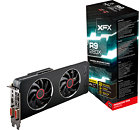
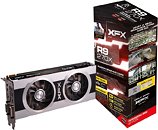
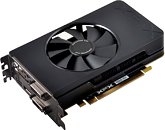
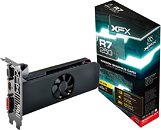
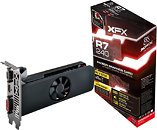
42 Comments on XFX' New Radeon R9 and R7 Series Of Graphics Cards Are An Evolution
Link here: www.hardwarecanucks.com/forum/hardware-canucks-reviews/63522-amd-radeon-r9-280x-3gb-review.html
I'd like to see how it compares to the 7750
Next would like clarification of Ghost and Double "D"... I thought Ghost was vapor chamber cooler and normally one fan, while D-D was traditional heat pipe cooler with double fan? Is there any real discernment as to what is what?
Double Dissipation = two fans.
You can have both since they're complementary - nothing stops you from having a vapor chamber and heatpipes and fans.
The TPU data base has most everything on them.
www.techpowerup.com/gpudb/2459/radeon-r7-250.html
www.techpowerup.com/gpudb/2463/radeon-r7-240.html
Judging by reviews of the 7730 which has the same specs clocked much lower, the R7 250 shouldn't be too far off a 7750.
But this "new" AMD and NV generation isn't very exciting to me. We need 20nm or whatever is next for manufacturing. That will be exciting and make this generation look like a waste of money. Both companies have new architectures to put on 20nm and it will add up.
R7 250 data has Memory Clock 1150 MHz (65W)
7790 1500 MHz 85W
www.techpowerup.com/gpudb/309/radeon-hd-7750.html
www.techpowerup.com/gpudb/2459/radeon-r7-250.html
www.techpowerup.com/gpudb/2100/radeon-hd-7790.html
www.anandtech.com/show/7400/the-radeon-r9-280x-review-feat-asus-xfx/20
And what other company gives a warranty as good as XFX ?..